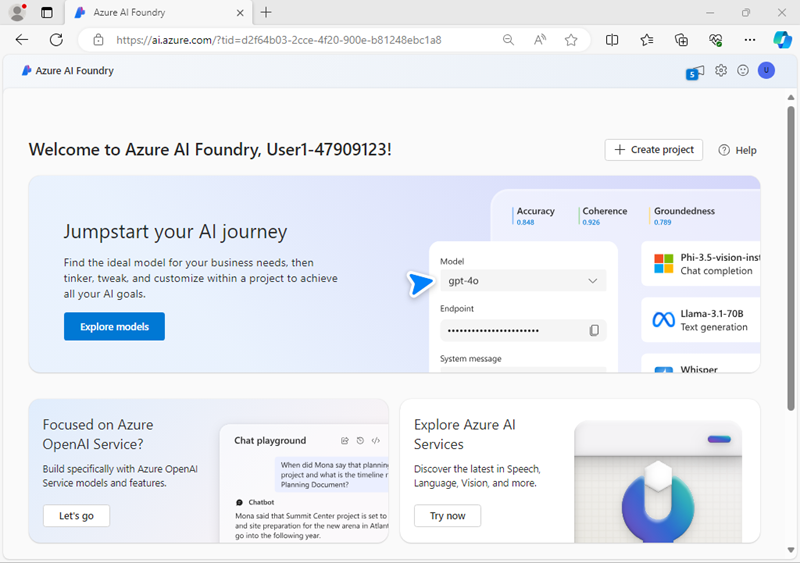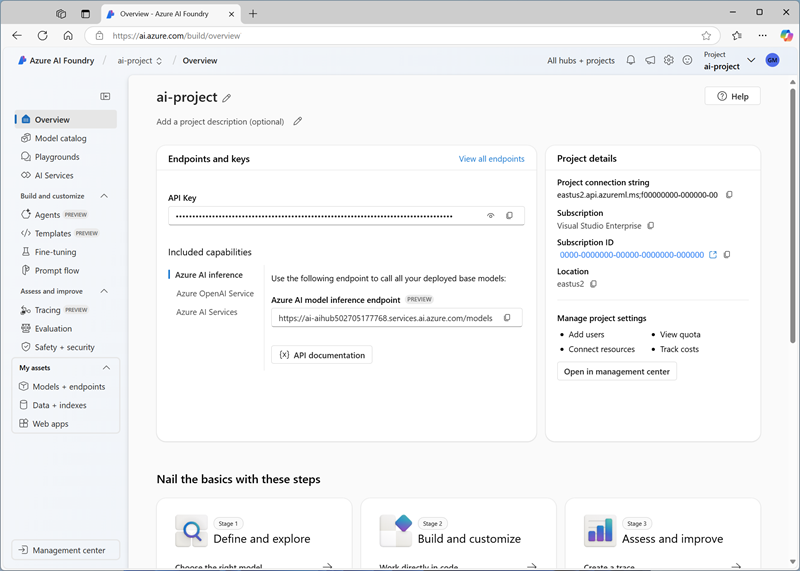Develop an audio-enabled chat app
In this exercise, you use the Phi-4-multimodal-instruct generative AI model to generate responses to prompts that include audio files. You'll develop an app that provides AI assistance for a produce supplier company by using Azure AI Foundry and the Python OpenAI SDK to summarize voice messages left by customers.
While this exercise is based on Python, you can develop similar applications using multiple language-specific SDKs; including:
- Azure AI Projects for Python
- OpenAI library for Python
- Azure AI Projects for Microsoft .NET
- Azure OpenAI client library for Microsoft .NET
- Azure AI Projects for JavaScript
- Azure OpenAI library for TypeScript
This exercise takes approximately 30 minutes.
Create an Azure AI Foundry project
Let's start by deploying a model in an Azure AI Foundry project.
-
In a web browser, open the Azure AI Foundry portal at
https://ai.azure.comand sign in using your Azure credentials. Close any tips or quick start panes that are opened the first time you sign in, and if necessary use the Azure AI Foundry logo at the top left to navigate to the home page, which looks similar to the following image:
-
In the home page, in the Explore models and capabilities section, search for the
Phi-4-multimodal-instructmodel; which we'll use in our project. -
In the search results, select the Phi-4-multimodal-instruct model to see its details, and then at the top of the page for the model, select Use this model.
-
When prompted to create a project, enter a valid name for your project and expand Advanced options.
-
Select Customize and specify the following settings for your hub:
- Azure AI Foundry resource: A valid name for your Azure AI Foundry resource
- Subscription: Your Azure subscription
- Resource group: Create or select a resource group
- Region: Select any AI Foundry recommended*
* Some Azure AI resources are constrained by regional model quotas. In the event of a quota limit being exceeded later in the exercise, there's a possibility you may need to create another resource in a different region. You can check the latest regional availability for specific models in the Azure AI Foundry documentation
-
Select Create and wait for your project to be created.
It may take a few moments for the operation to complete.
-
Select Agree and Proceed to agree to the model terms, then select Deploy to complete the Phi model deployment.
-
When your project is created, the model details will be opened automatically. Note the name of your model deployment; which should be Phi-4-multimodal-instruct
-
In the navigation pane on the left, select Overview to see the main page for your project; which looks like this:
Note: If an Insufficient permissions* error is displayed, use the Fix me button to resolve it.

Create a client application
Now that you deployed a model, you can use the Azure AI Foundry and Azure AI Model Inference SDKs to develop an application that chats with it.
Tip: You can choose to develop your solution using Python or Microsoft C#. Follow the instructions in the appropriate section for your chosen language.
Prepare the application configuration
-
In the Azure AI Foundry portal, view the Overview page for your project.
-
In the Project details area, note the Azure AI Foundry project endpoint. You'll use this endpoint to connect to your project in a client application.
-
Open a new browser tab (keeping the Azure AI Foundry portal open in the existing tab). Then in the new tab, browse to the Azure portal at
https://portal.azure.com; signing in with your Azure credentials if prompted.Close any welcome notifications to see the Azure portal home page.
-
Use the [>_] button to the right of the search bar at the top of the page to create a new Cloud Shell in the Azure portal, selecting a PowerShell environment with no storage in your subscription.
The cloud shell provides a command-line interface in a pane at the bottom of the Azure portal. You can resize or maximize this pane to make it easier to work in.
Note: If you have previously created a cloud shell that uses a Bash environment, switch it to PowerShell.
-
In the cloud shell toolbar, in the Settings menu, select Go to Classic version (this is required to use the code editor).
Ensure you've switched to the classic version of the cloud shell before continuing.
-
In the cloud shell pane, enter the following commands to clone the GitHub repo containing the code files for this exercise (type the command, or copy it to the clipboard and then right-click in the command line and paste as plain text):
rm -r mslearn-ai-audio -f git clone https://github.com/MicrosoftLearning/mslearn-ai-languageTip: As you paste commands into the cloudshell, the ouput may take up a large amount of the screen buffer. You can clear the screen by entering the
clscommand to make it easier to focus on each task. -
After the repo has been cloned, navigate to the folder containing the application code files:
cd mslearn-ai-language/Labfiles/09-audio-chat/Python -
In the cloud shell command line pane, enter the following command to install the libraries you'll use:
python -m venv labenv ./labenv/bin/Activate.ps1 pip install -r requirements.txt azure-identity azure-ai-projects openai -
Enter the following command to edit the configuration file that has been provided:
code .envThe file should open in a code editor.
-
In the code file, replace the your_project_endpoint placeholder with the endpoint for your project (copied from the project Overview page in the Azure AI Foundry portal), and the your_model_deployment placeholder with the name you assigned to your Phi-4-multimodal-instruct model deployment.
-
After you replace the placeholders, in the code editor, use the CTRL+S command or Right-click > Save to save your changes and then use the CTRL+Q command or Right-click > Quit to close the code editor while keeping the cloud shell command line open.
Write code to connect to your project and get a chat client for your model
Tip: As you add code, be sure to maintain the correct indentation.
-
Enter the following command to edit the code file:
code audio-chat.py -
In the code file, note the existing statements that have been added at the top of the file to import the necessary SDK namespaces. Then, Find the comment Add references, add the following code to reference the namespaces in the libraries you installed previously:
# Add references from azure.identity import DefaultAzureCredential from azure.ai.projects import AIProjectClient -
In the main function, under the comment Get configuration settings, note that the code loads the project connection string and model deployment name values you defined in the configuration file.
-
Find the comment Initialize the project client and add the following code to connect to your Azure AI Foundry project:
Tip: Be careful to maintain the correct indentation level for your code.
# Initialize the project client project_client = AIProjectClient( credential=DefaultAzureCredential( exclude_environment_credential=True, exclude_managed_identity_credential=True ), endpoint=project_endpoint, ) -
Find the comment Get a chat client, add the following code to create a client object for chatting with your model:
# Get a chat client openai_client = project_client.get_openai_client(api_version="2024-10-21")
Write code to submit an audio-based prompt
Before submitting the prompt, we need to encode the audio file for the request. Then we can attach the audio data to the user's message with a prompt for the LLM. Note that the code includes a loop to allow the user to input a prompt until they enter "quit".
-
Under the comment Encode the audio file, enter the following code to prepare the following audio file:
# Encode the audio file file_path = "https://github.com/MicrosoftLearning/mslearn-ai-language/raw/refs/heads/main/Labfiles/09-audio-chat/data/avocados.mp3" response = requests.get(file_path) response.raise_for_status() audio_data = base64.b64encode(response.content).decode('utf-8') -
Under the comment Get a response to audio input, add the following code to submit a prompt:
# Get a response to audio input response = openai_client.chat.completions.create( model=model_deployment, messages=[ {"role": "system", "content": system_message}, { "role": "user", "content": [ { "type": "text", "text": prompt }, { "type": "input_audio", "input_audio": { "data": audio_data, "format": "mp3" } } ] } ] ) print(response.choices[0].message.content) -
Use the CTRL+S command to save your changes to the code file. You can also close the code editor (CTRL+Q) if you like.
Sign into Azure and run the app
-
In the cloud shell command-line pane, enter the following command to sign into Azure.
az loginYou must sign into Azure - even though the cloud shell session is already authenticated.
Note: In most scenarios, just using az login will be sufficient. However, if you have subscriptions in multiple tenants, you may need to specify the tenant by using the --tenant parameter. See Sign into Azure interactively using the Azure CLI for details.
-
When prompted, follow the instructions to open the sign-in page in a new tab and enter the authentication code provided and your Azure credentials. Then complete the sign in process in the command line, selecting the subscription containing your Azure AI Foundry hub if prompted.
-
In the cloud shell command-line pane, enter the following command to run the app:
python audio-chat.py -
When prompted, enter the prompt
Can you summarize this customer's voice message? -
Review the response.
Use a different audio file
-
In the code editor for your app code, find the code you added previously under the comment Encode the audio file. Then modify the file path url as follows to use a different audio file for the request (leaving the existing code after the file path):
# Encode the audio file file_path = "https://github.com/MicrosoftLearning/mslearn-ai-language/raw/refs/heads/main/Labfiles/09-audio-chat/data/fresas.mp3"The new file sounds like this:
-
Use the CTRL+S command to save your changes to the code file. You can also close the code editor (CTRL+Q) if you like.
-
In the cloud shell command line pane beneath the code editor, enter the following command to run the app:
python audio-chat.py -
When prompted, enter the following prompt:
Can you summarize this customer's voice message? Is it time-sensitive? -
Review the response. Then enter
quitto exit the program.Note: In this simple app, we haven't implemented logic to retain conversation history; so the model will treat each prompt as a new request with no context of the previous prompt.
-
You can continue to run the app, choosing different prompt types and trying different prompts. When you're finished, enter
quitto exit the program.If you have time, you can modify the code to use a different system prompt and your own internet-accessible audio files.
Note: In this simple app, we haven't implemented logic to retain conversation history; so the model will treat each prompt as a new request with no context of the previous prompt.
Summary
In this exercise, you used Azure AI Foundry and the Azure AI Inference SDK to create a client application uses a multimodal model to generate responses to audio.
Clean up
If you've finished exploring Azure AI Foundry, you should delete the resources you have created in this exercise to avoid incurring unnecessary Azure costs.
- Return to the browser tab containing the Azure portal (or re-open the Azure portal at
https://portal.azure.comin a new browser tab) and view the contents of the resource group where you deployed the resources used in this exercise. - On the toolbar, select Delete resource group.
- Enter the resource group name and confirm that you want to delete it.